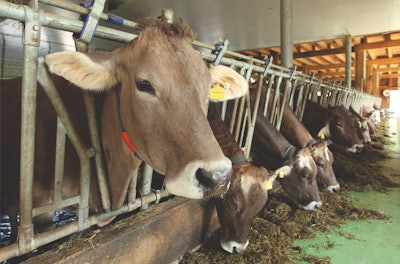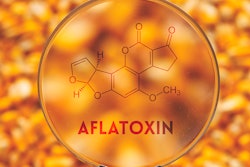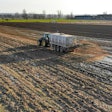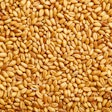
A growing number of feed additives claim to reduce emissions from livestock, but are they worthwhile?
Long before climate change came to dominate headlines that cast animal agriculture as the villain, livestock researchers had already envisioned a solution: feed additives with the ability to reduce livestock emissions.
On the surface, the solution was as elegant as it was simple. When ruminants such as cattle belch out methane, they lose small amounts of the energy associated with their feed. Perhaps, researchers thought there was a way to alter rumen fermentation that would not only reduce emissions but improve feed efficiency at the same time.
The hunch was a good one. In the 15 years since research into methane-reducing additives became popular, numerous prospective ingredients have emerged: essential oils, various chemicals and minerals, seaweeds, chilis and even various food waste products have all been shown to reduce enteric methane in one study or another. Yet, despite years of research, animal nutritionists say commercial viability is still a decade out for many of these promising additives.
“It has been shown that it is possible” to use feed additives to reduce emissions, said Alexander Hristov, a distinguished professor of dairy nutrition at Pennsylvania State University. “The question is whether it’s practical.”
Simple as the concept may seem, ongoing study has raised as many questions about using feed additives to reduce emissions as it has answered. Some additives show promise in one trial and not another. Others work, but the complicated nature of their production could create more emissions than they mitigate in livestock. And for many possibilities, the cost of production could prevent them from ever becoming practical options on the farm.
Aiming for consistency
Dozens of products claim to reduce emissions in cattle, and many are backed by university research. Acacia bark tannins, red macro-algae, Sapindus saponaria (western soapberry) fruit extracts and even some commonplace ingredients like oilseeds and coconut oil seem promising, according to Michael Kreuzer, a professor of animal nutrition in the department of environmental systems science at ETH Zurich. Other studies have considered Piper betle, Aloe vera, papaya, Moringa oleifera and numerous others.
Many of these additives are of interest to organic farmers not only for their emission-reducing benefits but because many plant extracts may have antioxidant, antibiotic, antiparasite and other co-benefits as well, according to Abubeker Hassen, an associated professor of ruminant nutrition and pasture science at the University of Pretoria.
Nevertheless, because of the natural nature of these products, achieving consistency has proven difficult, Kreuzer said.
These issues are particularly problematic in additives derived from plants — tannins, saponins, terpenes. All have shown promise in some studies, but not in others, and the discrepancies may be linked to variation in the chemicals themselves, according to Aaron Norris, a post-doctoral researcher who has studied these additives at Texas A&M and the University of Reno.
Organic compounds that can be produced in a laboratory setting, such as nitrates, sulfates and even synthetic compounds such as 3-nitrooxypropanol or 3NOP, may yield more consistent results. But these can come with concerns about digestibility and even toxicity. Nitrates, for example, reduce methane emissions for up to 10 weeks but can cause losses in production and even death in cattle if fed improperly.
 In addition to emission-reducing properties, plant extracts have antioxidant, antibiotic and other co-benefits. (kerdkanno | iStockPhoto.com)
In addition to emission-reducing properties, plant extracts have antioxidant, antibiotic and other co-benefits. (kerdkanno | iStockPhoto.com)Limitations despite promise
Red seaweed is a good example of a promising additive that may not be practical in production settings, said Hristov. It works, but if and only if the seaweed is handled properly.
The chemical compounds in the seaweed that is responsible for emission reduction are somewhat unstable, Hristov explains. To preserve them, the seaweed has to be carefully freeze-dried in a process that makes it too expensive for production applications. On top of that, the seaweed isn’t produced on any kind of commercial-scale — it would require a wild harvest, which would raise questions of ecological sustainability.
“You can’t have a wild harvest of seaweed to feed nine million dairy cows,” Hristov said.
Tannins, Norris said, have a similar problem, despite showing promise in some scientific trials. These plant extracts are only produced in a handful of regions and would require freeze-drying and careful shipping if use became widespread. The emissions associated with shipping and processing could outweigh the reductions that result from feeding the additive, Norris said.
This balancing act is difficult in countries like the U.S., where agriculture represents proportionately small greenhouse gas emissions compared to other industries. Agriculture produces just 5% of the greenhouse gasses released in the U.S., according to Hristov, with the remainder coming from other sectors such as transportation and energy.
“If we don’t take into account the trucking, the harvesting,” Norris said, “all of these things have an equal, potentially greater footprint than what we could gain on the animal side.”
Potential challenges
Questions about the viability of emission-reducing additives aren’t limited to societal benefits. There’s also reason to question whether a means exists for these additives to become financially beneficial to farmers.
Emission-reducing additives should, at least in theory, offer such benefits by reducing the energy lost to methane production. And there is some scientific evidence that certain additives live up to this promise — 3NOP, for example, appears to increase milk fat content and decrease methane emissions by 30%, Hristov said.
Others may cause harm to the animals that consume them. Many tannins, for example, reduce the digestibility of feed. Other additives reduce palatability and feed intake or have other drawbacks.
Hassen, whose team tested Acacia mearnsii tannins because they are already commercially available in South Africa, said they were able to overcome the digestibility issue in their trials by encapsulating the tannins. However, in long-term trials, he said, the emissions benefit faded with time. The microbes in the rumen may adapt to the tannin’s presence with extended feeding, he added.
Hassen believes many of the challenges associated with these additives can be addressed over time. Researchers are currently at work identifying the plant compounds that are responsible for reducing emissions and for other co-benefits hoping to produce standardized products.
“We are also busy studying genetic, environmental and management factors that affect the yield of plant extracts and composition of the plant extracts with a focus on Moringa olifera species,” he said.
However, there’s also the question of regulatory support. In Europe, for example, it appears likely farmers could receive government incentives to use emission-reducing additives. The U.S., on the other hand, has indicated that additives such as 3NOP may be regulated as drugs, which will increase the cost to produce them.
This pattern of regulatory support might be motivated by the unique needs of various countries, Hristov said. If the U.S., for example, reduces livestock emissions by half, it still wouldn’t put a dent in climate change because half of the nation’s livestock emissions represent 3% of its total greenhouse gas emissions. In other countries, such as New Zealand, agriculture represents as much as 40% of total greenhouse gas output. Globally, livestock is thought to produce 16-18% of total greenhouse gasses.
The discrepancy in emissions, in many cases, tied to the overall efficiency of livestock operations from one country to the next, Hristov said. So the true key to reducing emissions from agriculture may be in maximizing the productivity of each animal. But that can be time consuming and expensive, so he and others expect multiple emission-reducing additives will enter the market in the next 5-10 years.
And that’s not necessarily bad, Norris said, so long as users and manufacturers don’t oversimplify the costs and benefits.
“It’s not that I don’t believe we can’t find a way for it to be efficacious,” he said, “it’s that there is a whole line of things we have to get lined up to make it work.”
















